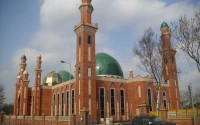New Geographies of Bradford: Islamic Architecture and a Sense of Place
- Date
- 12 May 2015
- Start time
- 7:30 PM
- Venue
- Tempest Anderson Hall
- Speaker
- Dr George Sheeran

New Geographies of Bradford: Islamic Architecture and a Sense of Place
A joint lecture with PLACE & the Royal Geographic Society
George Sheeran, Honorary Visiting Post-Doctoral Fellow, Division of Archaeological, Geographical and Environmental Sciences, University of Bradford
As towns and cities grew and developed in the nineteenth century they took on specific characters. They might be identified by the types of industries that resided there, and particular parts of towns might acquire qualities of their own and meanings for the people who lived there.
But over the past half century or so, many changes have taken place. Large areas of towns and cities have been cleared and replaced, traditional industries have declined, while some industrial towns have gained large migrant populations. All of this means that former perceptions of towns and cities can no longer be taken for granted: urban environments have been re-made and cultural landscapes have changed.
Using Bradford as a case study, Dr George Sheeran, a Visiting Fellow at the University of Bradford, will examine how Bradford has changed.
What we need, says Dr Sheeran, is a new geography of some of our towns and cities. Bradford is a good example of what I mean, since change there is not simply physical or economic, but cultural also. It is these changes that I shall be exploring in the course of this lecture.
Member’s report
Dr Sheeran differentiated the idea of place as a mere physical area from the idea of place as hauntings of passed habitation. This idea of place is one of successive groups of inhabitants infusing a place with their shared patterns of work, leisure, religion etc. Beginning with illustrated examples of urban redevelopment in Salford, including recommending The classic slum: Salford in the first quarter of the century by Robert Roberts, Dr Sheeran then turned to the nineteenth-century industrial development of Bradford. The shared community of people largely from the same class, with similar occupations and shared values, through their churches, which developed around the textile mills, dye works and brick works was described and illustrated.
In the mid twentieth century there was radical change with industrial modernising, post-war reconstruction and the easing of immigration with the 1948 British Nationality Act. The textile industry needed more workers and recruited them from Pakistan and Bangladesh. Secular buildings were at first adapted for community use as mosques but with urban redevelopment, and changing patterns of work, purpose built mosques were built at the centre of their communities, expressing their religious and cultural identity. By the 1990s bolder mosques, with varied architectural styles from around the world, were built, a reflection of the globalised culture of Bradford.
Catherine Brophy